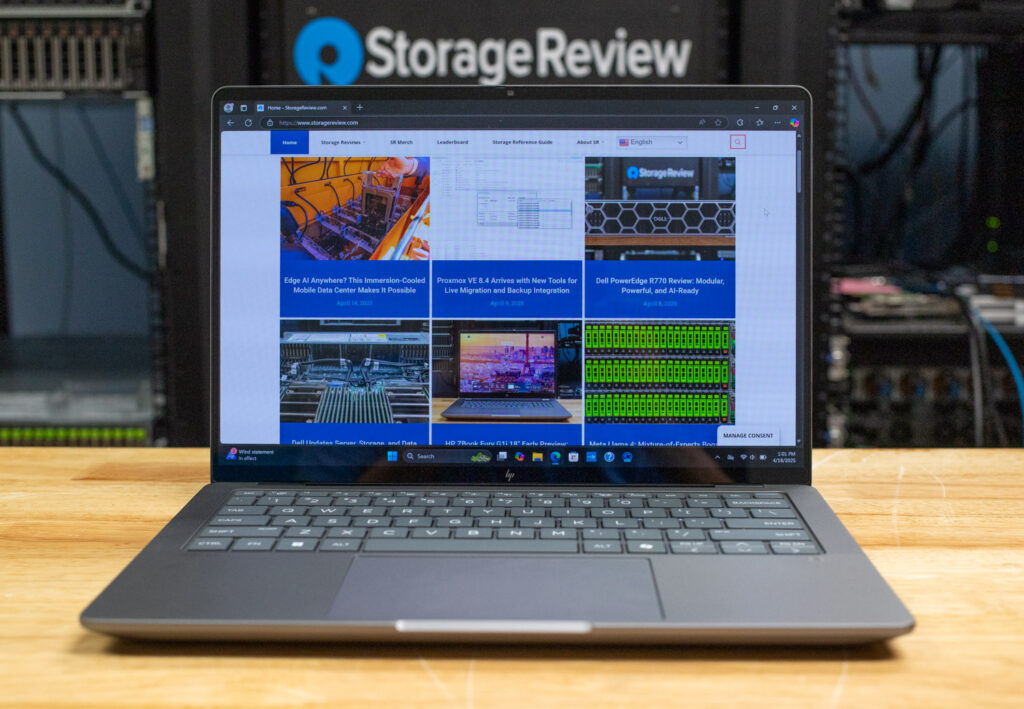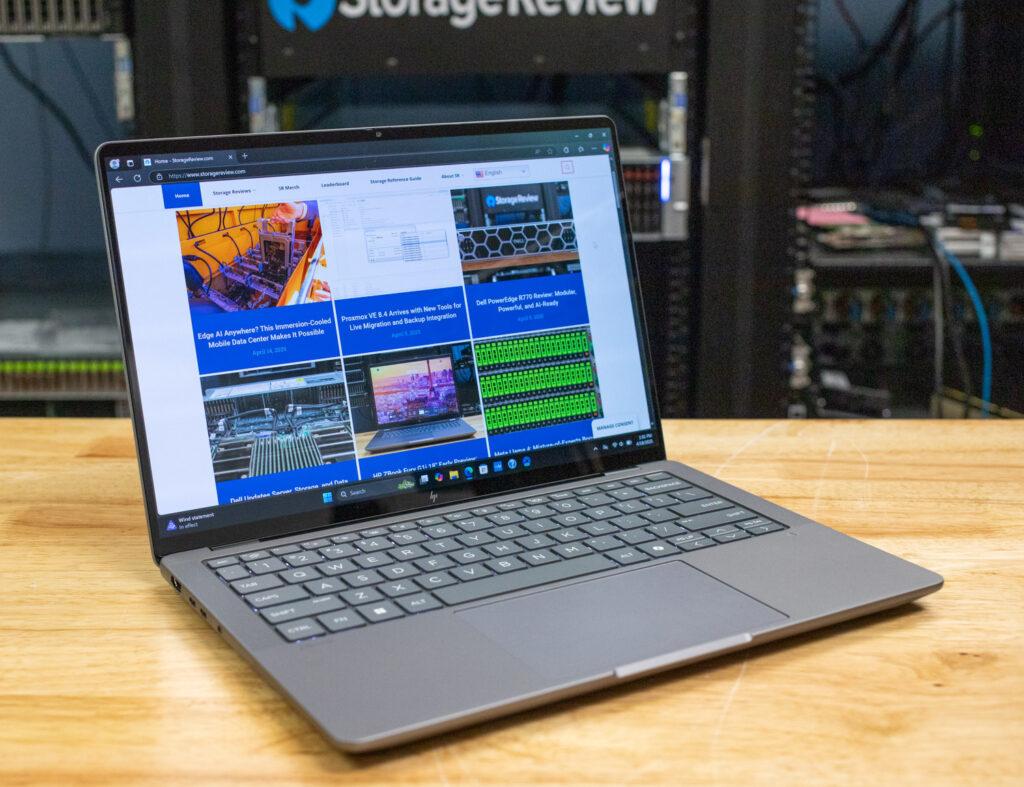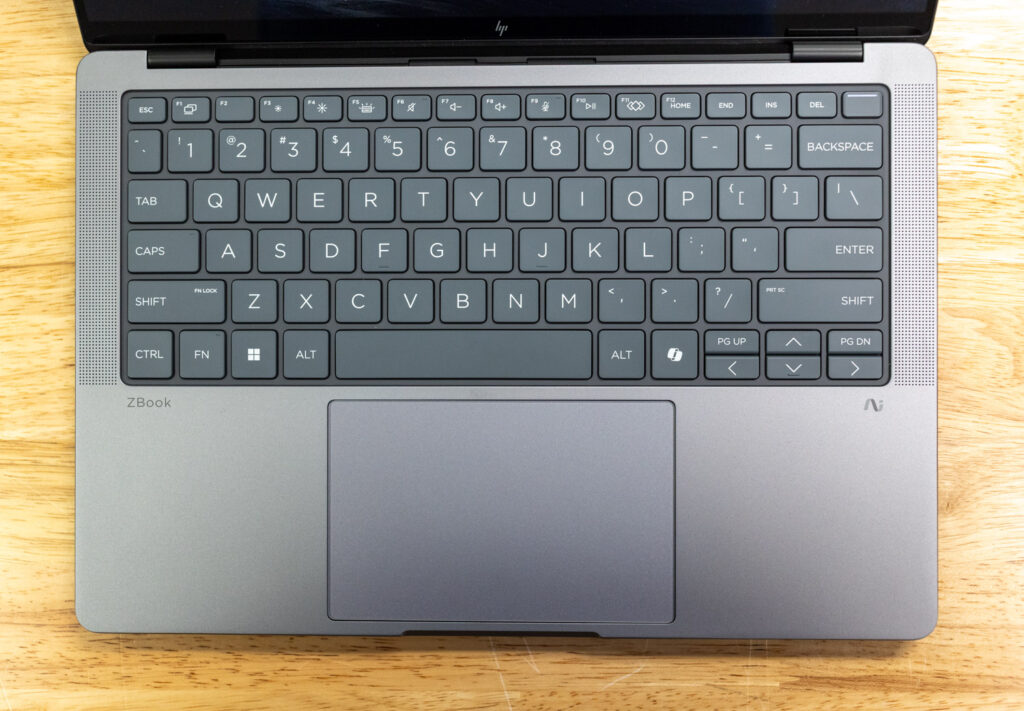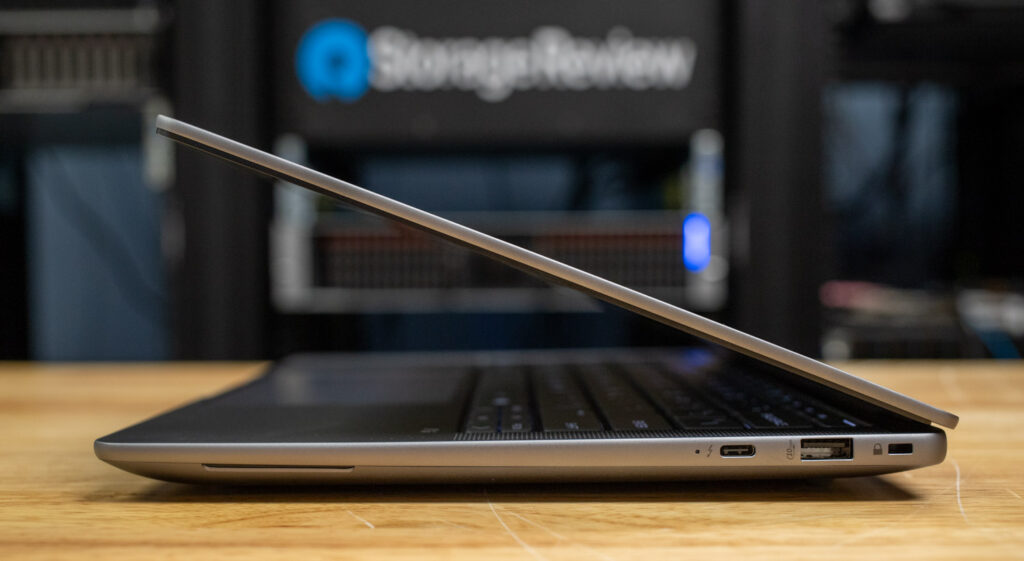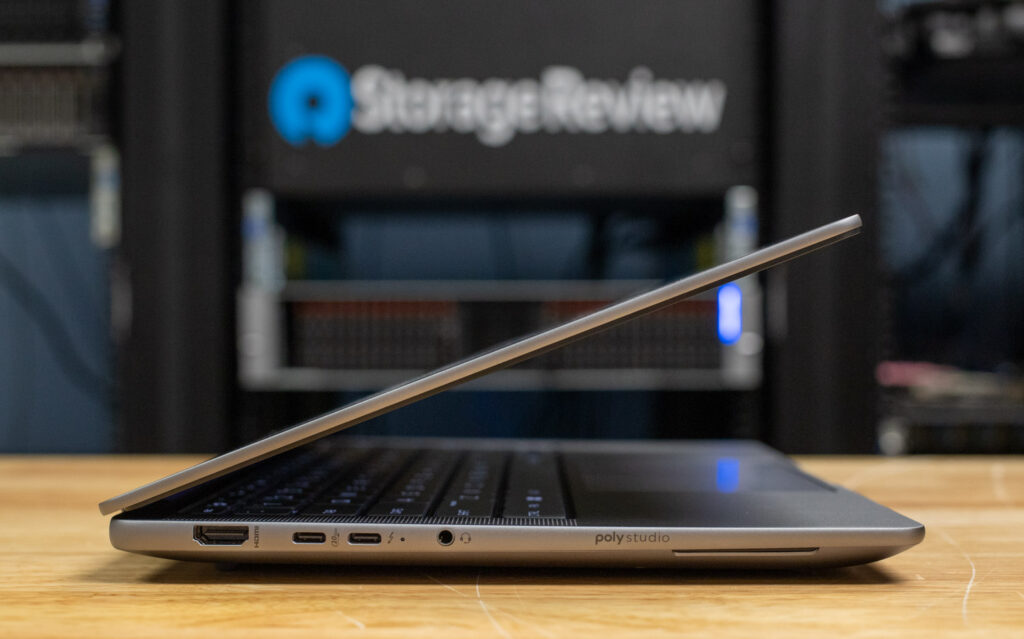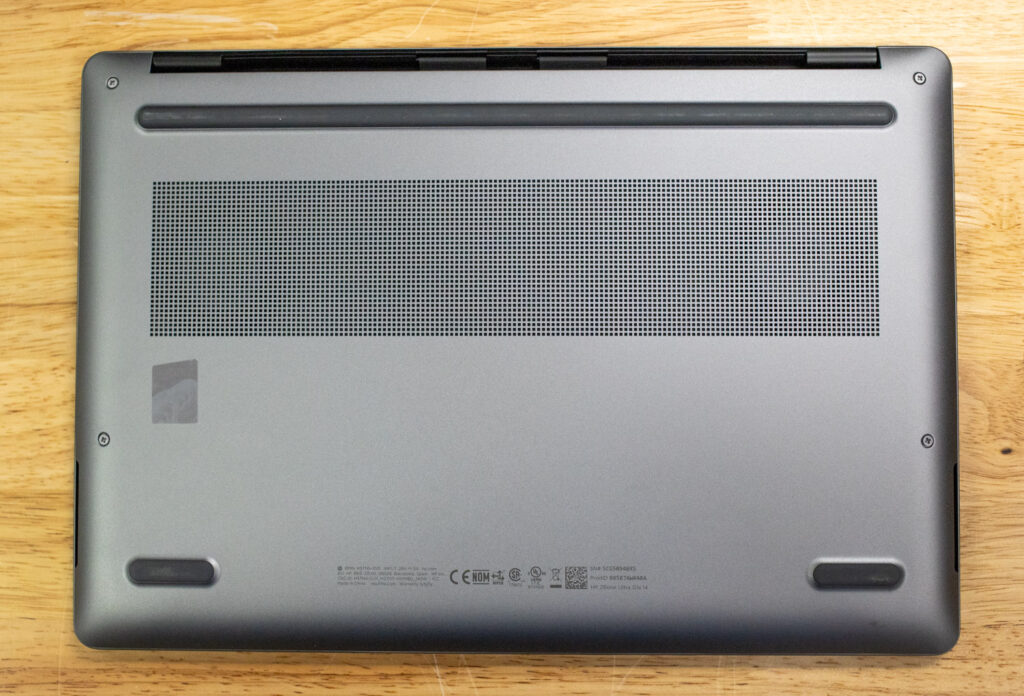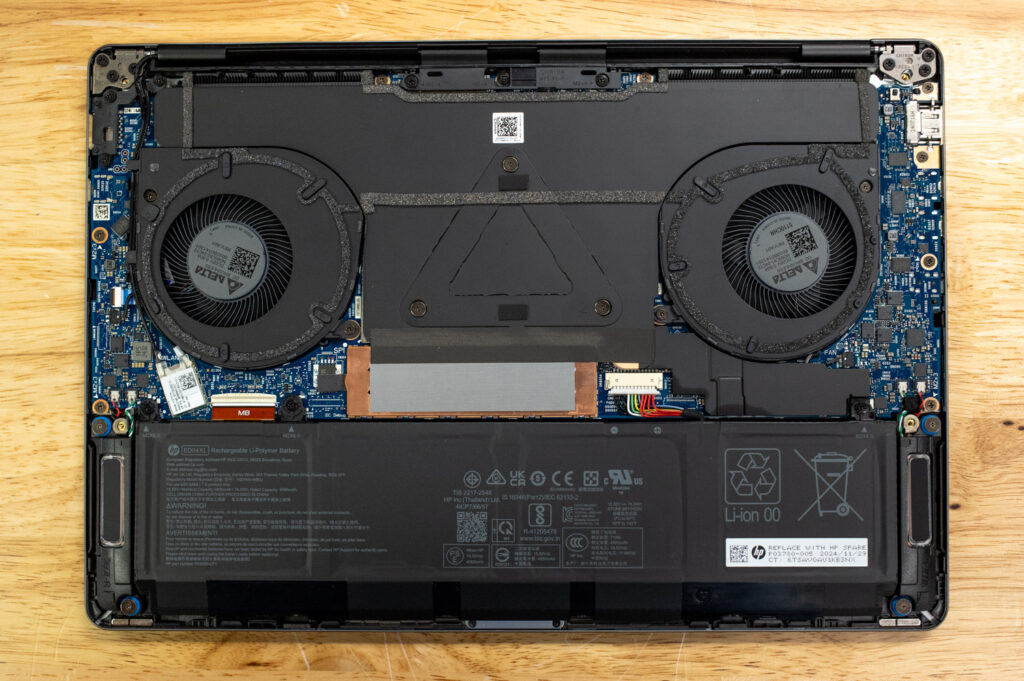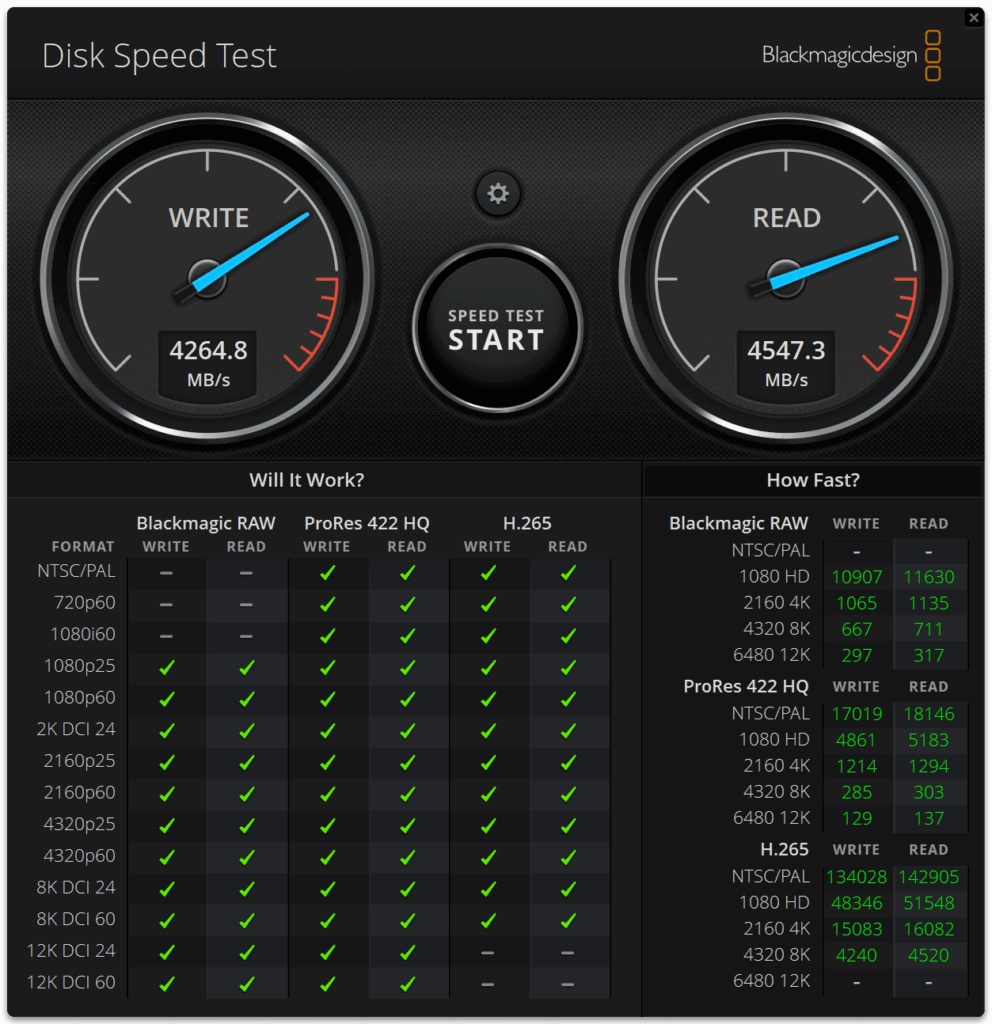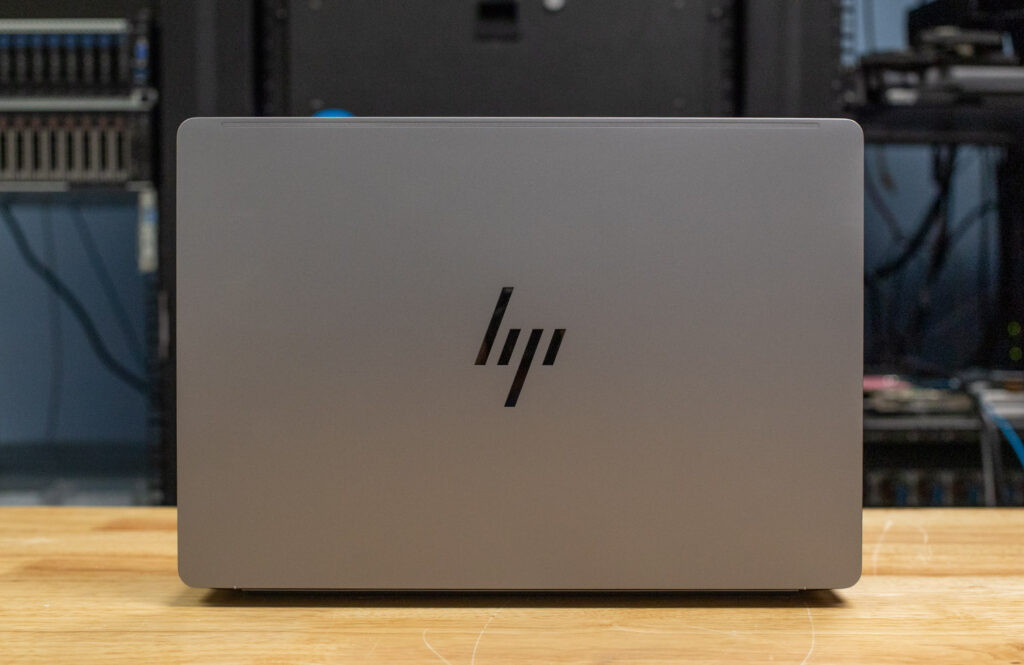The HP ZBook Ultra G1a 14″ offers strong specs but struggles to justify its steep price with performance, especially in AI workloads.
HP sent us the new HP ZBook Ultra G1a 14″ Mobile Workstation PC to the lab for review, and it’s clear that this machine represents a bold step forward in mobile workstation design. Notably, this is the first ZBook powered by an AMD processor. It is a significant shift for HP as it adopts AMD’s latest high-performance platform tailored for AI and advanced professional workloads. HP positions the ZBook Ultra G1a as a cutting-edge AI PC designed to handle demanding tasks that typically require desktop-level performance. Housed in a compact 14-inch chassis, it delivers workstation-class capabilities in a form factor designed for mobility and efficiency, making it a strong fit for professionals who need powerful performance wherever they work.
At the core of this system is the new AMD Ryzen™ AI Max PRO 300 Series processor (Formerly Strix Halo), featuring the Zen 5 architecture and offering up to 16 CPU cores. It also includes advanced Radeon™ 8060S graphics with dedicated AI accelerators. It is engineered to accelerate AI-enhanced workflows, from local large language model inference to real-time 3D rendering and modeling. A key feature is the unified memory architecture, which supports up to 128GB of shared memory, with up to 96GB that can be assigned directly to the GPU. This provides flexibility and performance comparable to traditional desktop systems.
The 128GB of shared memory opens up some interesting possibilities for the HP Zbook Ultra G1a, such as enhanced local LLM support. While most systems with less VRAM may be limited to smaller LLM parameter sizes, the G1a, with 96GB of VRAM, can accommodate almost all popular models. Leveraging LM Studio and Ollama, we could locally load models such as Deepseek-R1 70b or QwQ 32b.
The ZBook Ultra G1a also supports up to 4TB of NVMe storage, is ISV-certified for various creative and engineering applications, and delivers up to 50 TOPS of NPU performance for on-device AI tasks and productivity enhancements.
HP ZBook Ultra G1a 14-inch Mobile Workstation Specifications
| Specification | HP ZBook Ultra G1a 14 Mobile Workstation |
| Available Operating Systems |
|
| Processor Family | AMD Ryzen AI MAX PRO |
| Available Processors |
|
| Neural Processing Unit | AMD Ryzen AI (50 NPU TOPS) |
| Chipset | AMD integrated APU |
| Product Color | Meteor silver |
| Maximum Memory | 128 GB LPDDR5X-8533 MT/s non-ECC, Transfer rates up to 8000 MT/s |
| Internal Storage | 512 GB up to 4 TB PCIe Gen4 x4 NVMe M.2 2280 TLC SSD |
| Display Size (Diagonal) | 14″ / 35.6 cm |
| Display Options | 14″ WUXGA (1920 x 1200), UWVA, anti-glare, 400 nits, 100% sRGB 14″ 2.8K (2880 x 1800), OLED, UWVA, touch, 48-120 Hz, BrightView, Low Blue Light, 400 nits, 100% DCI-P3 |
| Available Graphics | Integrated: AMD Radeon 8060S, 8050S, 8040S Graphics |
| Audio | Audio by Poly Studio, 4 integrated stereo speakers (1W/8 ohm), discrete amplifiers, 2 integrated dual array digital microphones |
| Ports and Connectors | Left: 1 USB Type-C (10Gbps, USB PD, DisplayPort 2.1), 1 HDMI 2.1, 1 combo audio jack, 1 Thunderbolt 4 (40Gbps, USB PD, DisplayPort 2.1) Right: 1 USB Type-A 10Gbps signaling rate (charging); 1 security lock slot; 1 Thunderbolt 4 with USB Type-C 40Gbps signaling rate (USB Power Delivery, DisplayPort 2.1) |
| Keyboard | HP Premium spill-resistant backlit keyboard |
| Mouse | Microsoft Precision Touchpad with gesture support; Clickpad with image sensor and glass surface |
| Communications | Wi-Fi 7 MT7925 (2×2) and Bluetooth 5.4; NFC Mirage WNC XRAV-1 |
| Camera | 5 MP IR camera |
| Software | HP PC Hardware Diagnostics, HP Privacy Settings, HP Touchpoint Customizer, HP Support Assistant, HPX, HP Hotkey support, Battery Health Manager |
| Security Management | HP Tamper Lock (select models), HP TPM Configuration Utility, HP Sure Run Gen4, HP Client Security Manager, HP Sure Recover Gen4, Secured-core PC capable, TPM 2.0, Camera privacy shutter, HP Manageability Integration Kit, HP Sure Sense, HP Sure Start Gen6, Nano Security Lock Slot, HP Image Assistant Gen4.6 |
| Security Software Licenses | HP Wolf Pro Security Edition |
| Fingerprint Reader | Fingerprint reader (select models) |
| Management Features | HP Power Manager, HP Connect for Microsoft Endpoint Manager, HP Manageability Integration Kit, HP Image Assistant |
| Power | 140 W USB Type-C slim adapter |
| Battery Type | HP XL-Long Life 4-cell, 74.5 Wh polymer |
| Battery Recharge Time | HP Fast Charge: ~50% in 30 minutes |
| Dimensions | 31.22 x 21.55 x 1.85 cm / 12.29 x 8.48 x 0.73 in |
| Weight | Starting at 1.50 kg / 3.3 lb |
| Ecolabels | EPEAT® Gold with Climate+ |
| Sustainable Impact Specifications | Bulk packaging, 90% efficient power supply, 60% post-consumer recycled plastic, Low Halogen, 100% sustainable HP paper-based packaging |
As of this review, the HP ZBook Ultra G1a 14″ carries an entry price of $2,599 on the HP Store, with our particular configuration ringing in at a substantial $4,049 (on sale). HP pushes the envelope even further, offering configurations priced up to an eye-watering $8,250, positioning this as a high-end mobile AI workstation.
Build and Design: HP ZBook Ultra G1a 14-Inch
The HP ZBook Ultra G1a 14″, as the name suggests, features a 14-inch 2.8K (2880 x 1800) OLED touchscreen with ultra-wide viewing angles, a variable 48–120 Hz refresh rate, 100% DCI-P3 color coverage, 400 nits of brightness, and Low Blue Light technology for more comfortable viewing over long sessions. Housed in a precision-machined aluminum chassis finished in Meteor Silver, it balances sleek aesthetics and durable construction. A 5MP IR camera ensures sharp video quality and enables secure facial authentication with Windows Hello. The ZBook Ultra G1a measures 31.22 x 21.55 x 1.85 cm (12.29 x 8.48 x 0.73 inches) and weighs just 1.50 kg (3.3 pounds), making it highly portable without compromising build quality.
The HP ZBook Ultra G1a 14″ features a 75% compact (84-key) keyboard with HP’s Premium spill-resistant, backlit design. It includes a dedicated power button in the top-right corner and introduces the Copilot key for quick access to AI-powered assistance. The audio is enhanced with Poly Studio technology, delivering rich sound through four integrated stereo speakers.
The HP ZBook Ultra G1a 14″ features a Microsoft Precision Touchpad with full gesture support, offering smooth, responsive navigation. The clickpad design incorporates an image sensor beneath a glass surface, delivering precise input and a premium tactile experience.
On the right side of the HP ZBook Ultra G1a 14″, connectivity options include a USB Type-A port with a 10Gbps signaling rate and charging capability, a security lock slot, and a Thunderbolt 4 port with USB Type-C interface supporting 40Gbps data transfer, USB Power Delivery, and DisplayPort 2.1.
On the left side of the HP ZBook Ultra G1a 14″, you’ll find a USB Type-C port supporting 10Gbps data transfer, USB Power Delivery, and DisplayPort 2.1; an HDMI 2.1 port; a combo audio jack; and a Thunderbolt 4 port with 40Gbps signaling rate, supporting USB Power Delivery, and DisplayPort 2.1.
The HP ZBook Ultra G1a 14″ features a bottom cover with a wide air intake area to facilitate efficient cooling. However, unlike the ZBook Fury G1i 18″, this unit does not employ a toolless design. Four Philips screws secure the bottom cover.
Under the hood, the HP ZBook Ultra G1a 14″ features dual Delta cooling fans and a thermal design optimized for its high-performance components, including up to the AMD Ryzen AI Max+ PRO 395 processor with 16 cores, 45- 120W cTDP, and integrated with AMD Radeon 8060S graphics. It also offers Wi-Fi 7 (MT7925, 2×2), Bluetooth 5.4, NFC (Mirage WNC XRAV-1), a 74.5 Wh HP XL-Long Life 4-cell polymer battery, and a single Gen4 x4 NVMe M.2 2280 storage slot with heat shielding.
However, the RAM is soldered directly onto the motherboard, making it non-upgradable and non-serviceable. This means the amount of RAM you choose at purchase is fixed and cannot be increased later. The device supports configurations up to 128 GB LPDDR5X-8000 MT/s RAM, but it’s crucial to select the appropriate amount based on your long-term needs.
Performance: HP ZBook Ultra G1a 14-inch
System Configuration
| Component | Specification |
|---|---|
| Model | HP ZBook Ultra G1a 14-inch Mobile Workstation PC |
| CPU | AMD Ryzen AI MAX+ PRO 395 with Radeon 8060S |
| Memory | 128.00 GB @ 8000 MHz |
| GPU | AMD Radeon 8060S Graphics |
| Display | Internal Display 14.2″ (2880 × 1800) |
| Storage | WD PC SN810 2TB NVMe (1907.73 GB – SCSI) |
| Operating System | Microsoft Windows 11 Pro (Build 26100) |
In this section, we compare the performance of the HP ZBook Ultra G1a 14″ against two notable competitors:
- Lenovo ThinkPad X9 14 Aura Edition (Core Ultra 5 226V)
- HP EliteBook X G1a (Ryzen AI 9 HX 375)
- Lenovo ThinkPad P15 Gen 2(Intel Core i9-11950H)(NVIDIA RTX A5000)
This comparison will provide insights into how the ZBook Ultra G1a 14″ stands regarding processing power, graphics performance, and overall efficiency.
SPECworkstation 4.0.0
The SPECworkstation® 4.0 benchmark is a comprehensive tool to evaluate all key aspects of workstation performance. It offers a real-world measure of CPU, graphics, accelerator, and disk performance, ensuring professionals have the data to make informed decisions about their hardware investments. The benchmark includes a dedicated set of tests focusing on AI and ML workloads, including data science tasks and ONNX runtime-based inference tests, reflecting the growing importance of AI/ML in workstation environments. It encompasses seven industry verticals and four hardware subsystems, providing a detailed and relevant measure of the performance of today’s workstations.
The HP ZBook Ultra G1a 14″ turns in decent numbers across SPECworkstation 4.0.0, with its highest scores in Energy and Life Sciences (2.20 each), and respectable showings in Media & Entertainment (1.90) and Product Design (1.74). But for a system marketed as a mobile workstation, the results are more solid than standout. It outpaces the HP EliteBook X G1a (Ryzen AI 9 HX 375), which lands at 1.19 in Energy and 1.33 in Life Sciences, but the performance gap isn’t especially dramatic given the ZBook’s positioning. The Lenovo ThinkPad X9 14 Aura Edition (Core Ultra 5 226V) sits further behind, with much lower scores across the board—0.67 in Energy, 0.47 in Financial Services, and 0.71 in Life Sciences—clearly not built with heavier professional workloads in mind.
| SPECworkstation 4.0.0 (Higher is better) | HP ZBook Ultra G1a 14″(Ryzen AI MAX+ PRO 395) | Lenovo ThinkPad X9 14 Aura Edition (Core Ultra 5 226) | HP EliteBook X G1a (Ryzen AI 9 HX 375) |
| Energy | 2.20 | 0.67 | 1.19 |
| Financial Services | 1.60 | 0.47 | 1.12 |
| Life Sciences | 2.20 | 0.71 | 1.33 |
| Media & Entertainment | 1.90 | 0.78 | 1.32 |
| Product Design | 1.74 | 0.93 | 1.16 |
| Productivity & Development | 1.03 | 0.65 | 0.75 |
Blender OptiX
Blender is an open-source 3D modeling application. This benchmark was run using the Blender Benchmark utility. The score is samples per minute, with higher being better.
On the CPU side, the HP ZBook Ultra G1a 14″ with the Ryzen AI MAX+ PRO 395 shows solid performance in Blender’s rendering tests for a mobile system. It handles the Monster scene at 189.29 samples/min, followed by 129.42 in Junkshop and 94.14 in Classroom. While not exceptional by full workstation standards, it’s a strong showing for a compact 14″ form factor. The HP EliteBook X G1a with the Ryzen AI 9 HX 375 trails slightly behind, delivering 125.38 for Monster, 88.14 for Junkshop, and 63.11 for Classroom. Meanwhile, the Lenovo ThinkPad X9 14 Aura Edition (Core Ultra 5 226V) lands well behind both, with 57.85 for Monster, 35.63 for Junkshop, and 25.60 for Classroom—roughly a third of the ZBook’s output.
| Blender OptiX CPU (Samples per minute, Higher is better) (Higher is better) | HP ZBook Ultra G1a 14″(Ryzen AI MAX+ PRO 395) | Lenovo ThinkPad X9 14 Aura Edition (Core Ultra 5 226) | HP EliteBook X G1a (Ryzen AI 9 HX 375) |
| Monster | 189.29 | 57.85 | 125.38 |
| Junkshop | 129.42 | 35.63 | 88.14 |
| Classroom | 94.14 | 25.60 | 63.11 |
On the GPU side, HP ZBook Ultra G1a 14″, equipped with the Radeon 8060S, continues to impress. It delivers a Monster scene score of 661.50 samples/min, with 341.92 on Junkshop and 333.26 on Classroom. That’s some serious rendering performance from a mobile GPU, illustrating this Radeon chip isn’t just for show and a real contender for creative workflows. The Lenovo ThinkPad X9 14 Aura Edition, equipped with the Intel Arc 130V, yields lower numbers: 239.31 Monster, 106.86 Junkshop, and 108.77 Classroom. That’s about a third of the ZBook’s performance across these scenes, which is pretty consistent with what we saw on the CPU side.
| Blender OptiX GPU (Samples per minute, Higher is better) (Higher is better) | HP ZBook Ultra G1a 14″(Ryzen AI MAX+ PRO 395) | Lenovo ThinkPad X9 14 Aura Edition (Core Ultra 5 226) | HP EliteBook X G1a (Ryzen AI 9 HX 375) |
| Monster | 661.50 | 239.31 | 180.26 |
| Junkshop | 341.92 | 106.86 | 95.88 |
| Classroom | 333.26 | 108.77 | 90.66 |
Luxmark
Luxmark is a GPU benchmark that utilizes LuxRender, an open-source ray-tracing renderer, to evaluate a system’s performance in handling highly detailed 3D scenes. This benchmark is relevant for assessing the graphical rendering capabilities of servers and workstations, especially for visual effects and architectural visualization applications, where accurate light simulation is crucial.
Starting with the HP ZBook Ultra G1a 14″ (Ryzen AI MAX+ PRO 395), it dominates the field. In the Hallbench test, it scores 7,833, and in the Food scene, it scores 3,915. This shows the ZBook’s GPU is seriously up to the challenge for high-fidelity rendering. Now, shifting to the Lenovo ThinkPad X9 14 Aura Edition (Core Ultra 5 226V), there is a significant drop-off. It scores 2,870 on Hallbench and 1,329 on Food. Respectable, especially for a more power-efficient platform, but it’s not in the same league when it comes to heavy lifting in 3D rendering. Then there’s the HP EliteBook X G1a (Ryzen AI 9 HX 375)—and while it packs a decent chip, the numbers show it’s more tuned for general use than graphics-intensive workloads. It brings in 2,056 on Hallbench and 1,027 on the Food scene.
| Luxmark (Higher is better) | HP ZBook Ultra G1a 14″(Ryzen AI MAX+ PRO 395) | Lenovo ThinkPad X9 14 Aura Edition (Core Ultra 5 226) | HP EliteBook X G1a (Ryzen AI 9 HX 375) |
| Hallbench | 7,833 | 2,870 | 2,056 |
| Food | 3,915 | 1,329 | 1,027 |
7-Zip Compression
The 7-Zip Compression Benchmark evaluates CPU performance during compression and decompression tasks, measuring ratings in GIPS (Giga Instructions Per Second) and CPU usage. Higher GIPS and efficient CPU usage indicate superior performance.
The HP ZBook Ultra G1a 14″, powered by the Ryzen AI MAX+ PRO 395, flexes some serious multithreaded muscle here. Its Total Rating hits 156.832 GIPS, with a Compression Rating of 139.617 GIPS and Decompression at 174.046 GIPS. That’s high throughput, driven by sustained CPU usage nearing 2,870%—clearly pushing its 16 cores and 32 threads to get jobs done fast.
The HP EliteBook X G1a with the Ryzen AI 9 HX 375 trails somewhat behind but still posts strong results for a thin-and-light system: 102.564 GIPS Total, with 91.269 GIPS for Compression and 113.859 GIPS for Decompression. CPU usage remains high here as well, hovering just above 2,100%, showcasing good parallel utilization across its 12 cores and 24 threads.
In contrast, the Lenovo ThinkPad X9 14 Aura Edition (Core Ultra 5 226V) shows a much more modest performance. It reports a Total Rating of 46.112 GIPS, with 44.816 GIPS for Compression and 47.407 GIPS for Decompression. CPU usage stays under 730%, suggesting it’s limited by fewer available threads.
| 7-Zip Compression Benchmark | HP ZBook Ultra G1a 14″(Ryzen AI MAX+ PRO 395) | Lenovo ThinkPad X9 14 Aura Edition (Core Ultra 5 226V) | HP EliteBook X G1a (Ryzen AI 9 HX 375) |
| Compressing | |||
| Current CPU Usage | 2,868% | 697% | 2,177% |
| Current Rating/Usage | 4.883 GIPS | 6.219 GIPS | 4.091 GIPS |
| Current Rating | 140.061 GIPS | 43.375 GIPS | 89.082 GIPS |
| Resulting CPU Usage | 2,855% | 697% | 2,189% |
| Resulting Rating/Usage | 4.890 GIPS | 6.430 GIPS | 4.170 GIPS |
| Resulting Rating | 139.617 GIPS | 44.816 GIPS | 91.269 GIPS |
| Decompressing | |||
| Current CPU Usage | 2,904% | 742% | 2,103% |
| Current Rating/Usage | 6.029 GIPS | 6.241 GIPS | 5.327 GIPS |
| Current Rating | 175.104 GIPS | 46.309 GIPS | 112.052 GIPS |
| Resulting CPU Usage | 2,887% | 761% | 2,103% |
| Resulting Rating/Usage | 6.028 GIPS | 6.226 GIPS | 5.414 GIPS |
| Resulting Rating | 174.046 GIPS | 47.407 GIPS | 113.859 GIPS |
| Total Rating | |||
| Total CPU Usage | 2,871% | 729% | 2146% |
| Total Rating/Usage | 5.459 GIPS | 6.328 GIPS | 4.792 GIPS |
| Total Rating | 156.832 GIPS | 46.112 GIPS | 102.564 GIPS |
Blackmagic RAW Speed Test
The Blackmagic RAW Speed Test is a performance benchmarking tool that measures a system’s capabilities for handling video playback and editing using the Blackmagic RAW codec. It evaluates how well a system can decode and play back high-resolution video files, providing frame rates for both CPU- and GPU-based processing.
In the Blackmagic RAW Speed Test, the HP ZBook Ultra G1a 14″ delivers standout performance, handling 8K CPU decoding at 102 fps—over three times faster than the ThinkPad X9 and well ahead of the EliteBook X. On the 8K OpenCL (GPU) test, it maintains the lead at 78 fps, again outperforming the others. This makes the ZBook an excellent choice for high-res video editing and playback, especially in demanding post-production workflows.
| Blackmagic RAW Speed Test | HP ZBook Ultra G1a 14″(Ryzen AI MAX+ PRO 395) | Lenovo ThinkPad X9 14 Aura Edition (Core Ultra 5 226) | HP EliteBook X G1a (Ryzen AI 9 HX 375) |
|---|---|---|---|
| 8K CPU | 102 | 33 | 67 |
| 8K OPENCL | 78 | 42 | 30 |
Blackmagic Disk Speed Test
The Blackmagic Disk Speed Test evaluates storage performance by measuring read and write speeds, providing insights into a system’s ability to handle data-intensive tasks, such as video editing and large file transfers.
The HP ZBook Ultra G1a 14″ demonstrates modest storage performance in the Blackmagic Disk Speed Test. Powered by the WD PC SN810 2TB NVMe Gen 4 x4 drive, it achieves read speeds of 4,547.3 MB/s and write speeds of 4,264.8 MB/s. These high speeds make it well-suited for data-heavy tasks like video editing, 8K footage, and large file transfers.
y-cruncher
y-cruncher is a popular benchmarking and stress-testing application that launched in 2009. This test is multithreaded and scalable, computing Pi and other constants to trillions of digits. Faster is better in this test.
In the y-cruncher benchmark, the HP ZBook Ultra G1a 14″ dominates with significantly faster computation times across all tested digit levels. It calculates 1 billion digits of Pi in just 12.93 seconds, while the ThinkPad X9 lags far behind at 53.55 seconds. At 10 billion digits, the ZBook finishes in 171.72 seconds, nearly twice as fast as the EliteBook X. The ThinkPad couldn’t complete the larger workloads, further highlighting the ZBook’s exceptional multithreaded performance and thermal efficiency for heavy computational tasks.
| Y-Cruncher (Total Computation Time) | HP ZBook Ultra G1a 14″(Ryzen AI MAX+ PRO 395) | Lenovo ThinkPad X9 14 Aura Edition (Core Ultra 5 226) | HP EliteBook X G1a (Ryzen AI 9 HX 375) |
|---|---|---|---|
| 1 Billion | 12.93 s | 53.55 s | 22.51 s |
| 2.5 Billion | 34.91 s | 174.40 s | 73.80 s |
| 5 Billion | 78.19 s | N/A | 151.69 s |
| 10 Billion | 171.72 s | N/A | 309.28 s |
Geekbench 6
Geekbench 6 is a cross-platform benchmark that measures a system’s overall performance. The Geekbench Browser allows you to compare any system to it.
In Geekbench 6, the HP ZBook Ultra G1a 14″ outperforms the Lenovo ThinkPad X9 and HP EliteBook X in all categories. It scores 2,825 in CPU single-core, 17,562 in multi-core, and 85,337 in GPU, making it the most powerful option for both CPU and GPU tasks. The EliteBook X and ThinkPad X9 follow closely in terms of single-core and multi-core performance, but lag in GPU performance.
| Geekbench 6 (Higher is better) | HP ZBook Ultra G1a 14″(Ryzen AI MAX+ PRO 395) | Lenovo ThinkPad X9 14 Aura Edition (Core Ultra 5 226) | HP EliteBook X G1a (Ryzen AI 9 HX 375) |
|---|---|---|---|
| CPU Single-Core | 2,825 | 2,559 | 2,829 |
| CPU Multi-Core | 17,562 | 10,091 | 14,705 |
| GPU | 85,337 | 23,144 | 40,836 |
Cinebench R23
The Cinebench R23 benchmark tool evaluates a system’s CPU performance by rendering a complex 3D scene using the Cinema 4D engine. It measures single-core and multi-core performance, providing a comprehensive view of the CPU’s capabilities in handling 3D rendering tasks.
In Cinebench R23, the HP ZBook Ultra G1a 14″ delivers exceptional performance, with a multi-core score of 29,112, far outpacing the Lenovo ThinkPad X9 at 8,153 and the HP EliteBook X at 21,013. In single-core performance, the ZBook also leads with 1,984, followed by the EliteBook X at 1,798, and the ThinkPad X9 at 1,329. The ZBook excels in multi-core and single-core tasks, making it a powerful choice for 3D rendering and other CPU-intensive applications.
| Cinebench R23 (Higher is better) | HP ZBook Ultra G1a 14″(Ryzen AI MAX+ PRO 395) | Lenovo ThinkPad X9 14 Aura Edition (Core Ultra 5 226) | HP EliteBook X G1a (Ryzen AI 9 HX 375) |
|---|---|---|---|
| Multi-Core | 29,112 | 8,153 | 21,013 |
| Single-Core | 1,984 | 1,329 | 1,798 |
Cinebench 2024
Cinebench 2024 extends R23’s benchmark capabilities by adding GPU performance evaluation. It continues to test CPU performance but also includes tests that measure the GPU’s ability to handle rendering tasks.
In Cinebench 2024, the HP ZBook Ultra G1a 14″ again leads with a strong multi-core score of 1,579, outperforming the Lenovo ThinkPad X9 at 498 and the HP EliteBook X at 1,126. All three systems show similar single-core performance, with the ZBook and EliteBook both scoring 111, slightly ahead of the ThinkPad’s 109. This highlights the ZBook’s superior multi-core capabilities, making it ideal for tasks such as rendering and other multithreaded applications. All models performed comparably in single-core workloads.
| Cinebench 2024 (Higher is better) | HP ZBook Ultra G1a 14″(Ryzen AI MAX+ PRO 395) | Lenovo ThinkPad X9 14 Aura Edition (Core Ultra 5 226) | HP EliteBook X G1a (Ryzen AI 9 HX 375) |
|---|---|---|---|
| Multi-Core | 1,579 | 498 | 1,126 |
| Single-Core | 111 | 109 | 111 |
UL Procyon AI Computer Vision
The Procyon AI Computer Vision Benchmark comprehensively evaluates AI inference performance across various hardware and inference engines on Windows PCs and Apple Macs. This benchmark tests a range of real-world machine vision tasks using leading neural networks, including MobileNet V3, Inception V4, YOLO V3, DeepLab V3, Real-ESRGAN, and ResNet 50. It supports multiple inference engines, including NVIDIA TensorRT, Intel OpenVINO, Qualcomm SNPE, Microsoft Windows ML, and Apple Core ML, with float and integer model variants. Ideal for assessing AI accelerator performance and inference engine compatibility, this benchmark is fast, easy to use, and developed with input from industry experts.
AI Computer Vision CPU
In the UL Procyon AI Computer Vision CPU benchmark, the HP ZBook Ultra G1a 14″ (Ryzen AI MAX+ PRO 395) stands out with consistently faster inference times across all tested models, leading to the highest overall score of 186. Compared to the Lenovo ThinkPad X9 14 Aura Edition and HP EliteBook X G1a, which scored 65 and 91, respectively, the ZBook Ultra G1a handles even demanding models like YOLO V3 and Real-ESRGAN with significantly less latency. Whether it’s quick classification with MobileNet V3 or heavy image upscaling with Real-ESRGAN, the ZBook proves it’s built for efficient, on-device AI workloads.
| UL Procyon: AI Computer Vision Inference Times CPU (Lower is better) | HP ZBook Ultra G1a 14″(Ryzen AI MAX+ PRO 395) | Lenovo ThinkPad X9 14 Aura Edition (Core Ultra 5 226) | HP EliteBook X G1a (Ryzen AI 9 HX 375) |
|---|---|---|---|
| MobileNet V3 | 1.09 ms | 1.78 ms | 1.82 ms |
| ResNet 50 | 6.84 ms | 21.75 ms | 14.31 ms |
| Inception V4 | 19.80 ms | 65.42 ms | 43.55 ms |
| DeepLab V3 | 28.27 ms | 68.06 ms | 47.64 ms |
| YOLO V3 | 41.64 ms | 173.26 ms | 105.04 ms |
| Real-ESRGAN | 2138.97 ms | 6,743.22 ms | 4,565.56 ms |
| Overall Score (higher is better) | 186 | 65 | 91 |
AI Computer Vision GPU
When shifting AI workloads to the GPU, the HP ZBook Ultra G1a 14″ (Ryzen AI MAX+ PRO 395 with Radeon 8060S) flexes even more power, achieving an impressive overall score of 583 in the UL Procyon benchmark. Inference times drop dramatically compared to CPU, with tasks like YOLO V3 and DeepLab V3 completing in just over 10 ms. Even the intensive Real-ESRGAN model runs nearly 10x faster on a GPU.
| UL Procyon: AI Computer Vision Inference Times GPU (Lower is better) | HP ZBook Ultra G1a 14″(Ryzen AI MAX+ PRO 395)(Radeon 8060S) | HP EliteBook X G1a (Ryzen AI 9 HX 375) |
|---|---|---|
| MobileNet V3 | 0.46 ms | 0.90 ms |
| ResNet 50 | 3.27 ms | 7.30 ms |
| Inception V4 | 11.62 ms | 17.35 ms |
| DeepLab V3 | 10.72 ms | 26.50 ms |
| YOLO V3 | 10.57 ms | 19.98 ms |
| Real-ESRGAN | 200.40 ms | 495.60 ms |
| Overall Score (higher is better) | 583 | 283 |
AI Computer Vision NPU
The HP ZBook Ultra G1a 14″ reaches new heights in AI performance with its Ryzen AI MAX+ PRO 395 and dedicated NPU, posting an impressive overall score of 1,773 in the UL Procyon benchmark. Inference times are lightning-fast, with MobileNet V3 at 0.27 ms and even YOLO V3 in just 3.15 ms, demonstrating the NPU’s ability to handle complex models with ease. Real-ESRGAN, typically a heavy task, is completed in just over 100 ms.
| UL Procyon: AI Computer Vision Inference Times NPU (Lower is better) | HP ZBook Ultra G1a 14″(Ryzen AI MAX+ PRO 395)(Radeon 8060S) |
|---|---|
| MobileNet V3 | 0.27 ms |
| ResNet 50 | 0.82 ms |
| Inception V4 | 1.71 ms |
| DeepLab V3 | 4.22 ms |
| YOLO V3 | 3.15 ms |
| Real-ESRGAN | 100.83 ms |
| Overall Score (higher is better) | 1,773 |
UL Procyon AI Text Generation
The Procyon AI Text Generation Benchmark simplifies AI LLM performance testing by offering a compact and consistent evaluation method. It allows for repeated testing across multiple LLM models while minimizing the complexity of large model sizes and variable factors. Developed with AI hardware leaders, it optimizes the use of local AI accelerators for more reliable and efficient performance assessments. The results measured below were tested using TensorRT on the NVIDIA models and ONNX for the AMD models.
We observed a clear performance distinction when comparing the HP ZBook Ultra G1a featuring the AMD Ryzen AI MAX+ PRO 395 processor and integrated Radeon 8060S graphics against the Lenovo ThinkPad X9 14 Aura Edition equipped with Intel’s Core Ultra 5 226 CPU and Arc graphics, as well as the Lenovo ThinkPad P15 Gen 2 reviewed back in 2021, which includes an Intel Core i9-11950H CPU and NVIDIA RTX A5000 GPU. While the ZBook boasts an advanced architecture and significant assignable VRAM, real-world AI benchmarks reveal it lags behind both Lenovo models.
In testing with the Phi model, the ZBook achieved an overall score of 922, with a time-to-first-token of 1.956 seconds and a token generation rate of 64.99 tokens per second. By comparison, the ThinkPad X9 Aura scored slightly lower at 829, with a faster first token generation time of 1.064 seconds, albeit a slower token throughput of 28.53 tokens per second, resulting in an overall longer duration. The ThinkPad P15 Gen 2 significantly outperformed both, scoring 2,303, with an impressive first token time of 0.427 seconds and throughput of 88.48 tokens per second.
The Mistral model further highlighted performance dynamics, where the ZBook’s score of 829 and 41.99 tokens per second surpassed the Aura’s lower score of 741 and notably slower throughput of 17.57 tokens per second. However, the Aura maintained quicker initial responsiveness at 1.457 seconds compared to the ZBook’s 2.783 seconds. Again, the ThinkPad P15 Gen 2 demonstrated superior performance, scoring 2,059 and achieving a throughput of 63.65 tokens per second.
For Llama3, the ZBook’s performance remained ahead of Aura with a score of 756 against Aura’s 690, along with higher throughput (36.24 tokens/s vs. Aura’s 15.50 tokens/s). Yet again, Aura’s Arc graphics offered faster initial responsiveness, at 1.324 seconds, versus ZBook’s 2.578 seconds. Meanwhile, the ThinkPad P15 Gen 2 dominated this comparison, scoring 1,891 and a throughput of 55.68 tokens per second.
While the ZBook Ultra G1a generally outperformed the ThinkPad X9 Aura in sustained token throughput, it significantly underperformed compared to the older, discrete GPU-equipped ThinkPad P15 Gen 2. Given its premium cost and positioning, the ZBook’s integrated AMD graphics fell short compared to both discrete and integrated solutions. Additionally, changing the DRAM allocation from 16GB to 96GB, for example, had little to no impact on benchmark results. This testing shows that while AMD’s new platform offers a promising architecture and generous memory handling, the GPU component doesn’t match the raw power of discrete, professional-grade graphics cards. In practical terms, the ZBook Ultra G1a doesn’t yet live up to its full potential for heavy AI workloads, particularly when latency and throughput are most important.
| UL Procyon: AI Text Generation | HP ZBook Ultra G1a 14″ (Ryzen AI MAX+ PRO 395)(Radeon 8060S) | Lenovo ThinkPad P15 Gen 2 (Intel Core i9-11950H)(NVIDIA RTX A5000) | Lenovo ThinkPad X9 14 Aura Edition (Core Ultra 5 226) | HP EliteBook X G1a 14″ (AMD Ryzen AI 9 HX PRO 375 w/ Radeon 890M) |
|---|---|---|---|---|
| Phi Overall Score | 922 | 2,303 | 829 | 400 |
| Phi Output Time To First Token | 1.956 s | 0.427 s | 1.064 s | 5.012 s |
| Phi Output Tokens Per Second | 64.986 tokens/s | 88.483 tokens/s | 28.534 tokens/s | 31.313 tokens/s |
| Phi Overall Duration | 55.501 s | 33.574 s | 105.453 s | 122.604 s |
| Mistral Overall Score | 829 | 2,059 | 741 | 361 |
| Mistral Output Time To First Token | 2.783 s | 0.684 s | 1.457 s | 7.497 s |
| Mistral Output Tokens Per Second | 41.992 tokens/s | 63.654 tokens/s | 17.568 tokens/s | 21.451 tokens/s |
| Mistral Overall Duration | 84.065 s | 47.229 s | 163.967 s | 178.492 s |
| Llama3 Overall Score | 756 | 1,891 | 690 | 321 |
| Llama3 Output Time To First Token | 2.578 s | 0.633 s | 1.324 s | 7.062 s |
| Llama3 Output Tokens Per Second | 36.243 tokens/s | 55.680 tokens/s | 15.501 tokens/s | 17.872 tokens/s |
| Llama3 Overall Duration | 93.200 s | 53.680 s | 176.943 s | 201.701 s |
| Llama2 Overall Score | 929 | 1,892 | N/A | 341 |
| Llama2 Output Time To First Token | 3.860 s | 1.954 s | N/A | 12.542 s |
| Llama2 Output Tokens Per Second | 24.619 tokens/s | 30.625 tokens/s | N/A | 10.760 tokens/s |
| Llama2 Overall Duration | 136.720 s | 96.163 s | N/A | 339.281 s |
UL Procyon AI Image Generation
The Procyon AI Image Generation Benchmark consistently and accurately measures AI inference performance across various hardware, from low-power NPUs to high-end GPUs. It includes three tests: Stable Diffusion XL (FP16) for high-end GPUs, Stable Diffusion 1.5 (FP16) for moderately powerful GPUs, and Stable Diffusion 1.5 (INT8) for low-power devices. The benchmark uses the optimal inference engine for each system, ensuring fair and comparable results.
The UL Procyon AI Image Generation Benchmark illustrates the performance disparity between the HP ZBook Ultra G1a 14″ and the Lenovo ThinkPad P15 Gen 2, primarily when tasked with running high-demand image synthesis workloads using Stable Diffusion models. While the ZBook features AMD’s Ryzen AI MAX+ PRO 395 paired with Radeon 8060S graphics, it struggles to keep pace with Lenovo’s Intel Core i9-11950H and NVIDIA RTX A5000 combination, a setup designed for heavy GPU-accelerated tasks.
When running Stable Diffusion 1.5 (FP16), the ZBook scored 648 and took a total of 154.2 seconds to complete the test, with an average generation time of 9.64 seconds per image. On the other hand, the ThinkPad more than doubled that performance, scoring 1,287. It completed the workload in 77.64 seconds and generated each image in just 4.85 seconds, essentially twice as fast.
The gap widened even further in the Stable Diffusion XL (FP16) test, a model designed to push high-end GPUs. Here, the ZBook managed a score of 451, but at a substantial cost: over 1,329 seconds total and a glacial 83.1 seconds per image. Compared to the Lenovo unit, the same workload was completed in just 554.6 seconds, generating images at a far more efficient rate of 34.66 seconds per image, while posting a score of 1,081.
These results reinforce that the ZBook Ultra G1a’s integrated Radeon GPU, while sufficient for lighter tasks and perhaps suited for basic AI-assisted workloads, doesn’t deliver the kind of speed or responsiveness needed for heavy image generation workflows. The RTX A5000’s dedicated horsepower enables the ThinkPad to process complex models, such as Stable Diffusion XL, significantly faster, offering better scalability and turnaround for professionals working in visual AI domains. Despite AMD’s push toward AI integration with Ryzen and RDNA, this generation of mobile workstation still has considerable ground to cover when it comes to GPU-driven inference workloads.
| UL Procyon: AI Image Generation (overall score: higher is better) | HP ZBook Ultra G1a 14″(Ryzen AI MAX+ PRO 395)(Radeon 8060S) | Lenovo ThinkPad P15 Gen 2(Intel Core i9-11950H)(NVIDIA RTX A5000) | HP EliteBook X G1a 14″ (AMD Ryzen AI 9 HX PRO 375 w/ Radeon 890M) |
|---|---|---|---|
| Stable Diffusion 1.5 (FP16) — Overall Score | 648 | 1,287 | 261 |
| Stable Diffusion 1.5 (FP16) — Overall time | 154.203 s | 77.642 s | 382.380 s |
| Stable Diffusion 1.5 (FP16) — image generation speed | 9.638 s/image | 4.853 s/image | 23.899 s/image |
| Stable Diffusion XL (FP16) — Overall Score | 451 | 1,081 | 181 |
| Stable Diffusion XL (FP16) — Overall time | 1329.592 s | 554.576 s | 3310.768 s |
| Stable Diffusion XL (FP16) — image generation speed | 83.100 s/image | 34.661 s/image | 206.923 s/image |
Conclusion
The ZBook Ultra G1a impresses with its advanced specifications, including up to 128GB of LPDDR5X RAM, a high-quality 2.8K OLED display, and various storage options, making it a formidable choice for professionals who need workstation-class power. It represents an ambitious entry by HP into the AMD Ryzen AI MAX+ PRO platform, aiming to deliver significant processing power and portability for traditional workstation tasks. The system excels in CPU-intensive workloads, 3D rendering, and general productivity, demonstrated through robust SPECworkstation, Blender, and Cinebench results. However, when scrutinizing its performance in AI-driven applications, central to AMD’s marketing of the Ryzen AI MAX+ PRO series, the ZBook Ultra G1a stumbles significantly.
Despite the impressive hardware specifications on paper, particularly the generous dynamic allocation of up to 96GB of VRAM, actual AI performance benchmarks highlight the platform’s shortcomings. In text generation tests using popular LLM models, such as Phi, Mistral, Llama3, and Llama2, the ZBook consistently lagged behind older, more traditionally equipped dedicated GPUs, like the NVIDIA A5000. The ZBook’s token generation rates were notably slower, at 36.24 tokens/s with Llama3, compared to 55.68 tokens/s for the ThinkPad, and its output latency was substantially higher, undermining real-world usability.
This performance gap widened further in demanding AI image generation benchmarks, including Stable Diffusion 1.5 and Stable Diffusion XL. In these tests, the ZBook Ultra G1a’s Radeon 8060S GPU struggled significantly, taking over twice as long as Lenovo’s RTX A5000-powered workstation to complete identical tasks. For example, image generation speeds for Stable Diffusion XL were 83.1 seconds per image on the ZBook, compared to just 34.66 seconds per image on the Lenovo ThinkPad.
It’s not just the low AI performance that causes problems for this system. When decked out with the AMD Ryzen AI MAX+ PRO 395, featuring 128GB of RAM and a 4TB SSD, you’ll be out $8,250. The model with a 1TB SSD is priced at $6,445. What is perplexing, though, and possibly a price swayed by initial promotion, is that the 2TB SSD variant costs just $4,049. For reference, this system’s top build costs more than the Razer 16 we reviewed, which is configured with the NVIDIA GeForce RTX 5090. It’s also priced so high with the 4TB version that you can’t build an Apple MacBook Pro 14 or 16 to be more expensive; those top out at $7,049 and $7,349, respectively, with an 8TB SSD. If performance met the price, this might not be an issue. However, we have numerous AI workloads where this system is barely treading water compared to a $1,239 notebook with Intel integrated graphics and 16GB of total system memory.
While the HP ZBook Ultra G1a 14″ shines in general workstation tasks, the AMD Ryzen AI MAX+ PRO platform’s AI-specific performance does not meet the expectations HP and AMD set, especially at this price point. If this were a thin and light mobile workstation with a $2500 price tag, we could get behind the G1a. But as it is, there’s no way to justify the absurd price HP is seeking here. Even if we discount the HP store’s pricing and consider that most ZBooks are sold through the channel, it would take an additional 40-50% off the SALE PRICE of $4050 our review unit carries to make it competitive based on its performance. While we were excited for the dynamic memory, AI potential, and the return of AMD to the ZBook portfolio, we couldn’t be more underwhelmed by this effort.
Engage with StorageReview
Newsletter | YouTube | Podcast iTunes/Spotify | Instagram | Twitter | TikTok | RSS Feed

